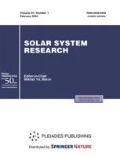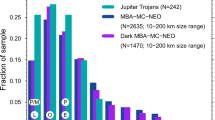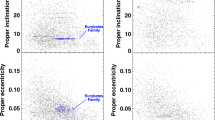Abstract
The current concepts on the physical properties of the Jovian Trojans are reviewed in the paper. The distributions of rotation periods and light-curve amplitudes, the features of the phase dependencies of brightness, and the available data on the surface composition, density, diameters, and albedo of the Trojans are analyzed. The history of the discovery of Trojans, their dynamical properties, and the hypotheses on their origin are also briefly considered. A framework of the unsolved problems in the study of this population of small bodies is outlined.
Similar content being viewed by others
References
Abdul’myanov, T.R. and Zagretdinov, R.V., Asteroids libration motion near mean motions commensurability. Intermediate orbits, Kinemat. Fiz. Nebesn. Tel, 1994, vol. 4, pp. 34–43.
Alexandersen, M., Gladman, B., Greenstreet, S., Kavelaars, J.J., Petit, J.-M., and Gwyn, S., A Uranian Trojan and the frequency of temporary giant-planet coorbitals, Science, 2013, vol. 341, pp. 994–997.
Barucci, M.A., Cruikshank, D.P., Mottola, S., and Lazzarin, M., Physical properties of Trojan and Centaur asteroids, in Asteroids III, Bottke, W.F., Jr., Ed., Tucson: Univ. Arizona Press, 2002, pp. 273–287.
Beaugé, C. and Roig, F.A., Semianalytical model for the motion of the Trojan asteroids: proper elements and families, Icarus, 2001, vol. 153, pp. 391–415.
Belskaya, I.N., Surface optical properties for asteroids, Centauruses and Kuiper belt bodies surfaces, Doctoral Sci. (Phys.-Math.) Dissertation, Kharkov, 2007.
Bendjoya, P., Cellino, A., Di Martino, D., and Saba, L., Spectroscopic observations of Jupiter Trojans, Icarus, 2004, vol. 168, pp. 374–384.
Binzel, R.P. and Sauter, L.M., Trojan, Hilda, and Cybele asteroids: new lightcurve observations and analysis, Icarus, 1992, vol. 95, pp. 222–238.
Bowell, E., Hapke, B., and Domingue, D., Application of photometric models to asteroids, in Asteroids II, Binzel, R.P., et al., Eds., Tucson: Univ. Arizona Press, 1989, pp. 524–556.
Chapman, C.R., Morrison, D., and Zellner, B., Surface properties of asteroids-a synthesis of polarimetry, radiometry, and spectrophotometry, Icarus, 1975, vol. 25, pp. 104–130.
Chebotarev, G.A., New types of motions for Trojan group planets, Astron. Zh., 1973, vol. 50, no. 5, pp. 1071–1075.
Chiang, E.I., Jordan, A.B., Millis, R.L., et al., Resonance occupation in the Kuiper Belt: case examples of the 5: 2 and Trojan resonances, Astron. J., 2003, vol. 126, pp. 430–443.
Ciesla, F.J. and Cuzzi, J.N., The evolution of the water distribution in a viscous protoplanetary disk, Icarus, 2006, vol. 181, pp. 178–204.
Connors, M.G., Wiegert, P., and Veillet, C., Discovery of an Earth Trojan asteroid, Nature, 2011, vol. 475, pp. 481–483.
Cruikshank, D.P., Radii and albedos of four Trojan asteroids and Jovian satellites 6 and 7, Icarus, 1977, vol. 30, pp. 224–230.
Cruikshank, D.P., Dall’Ore, C.M., Roush, T.L., et al., Constraints on the composition of Trojan asteroid 624 Hektor, Icarus, 2001, vol. 153, pp. 348–360.
Cruikshank, D.P., Wegryn, E., and Dalle Ore, C.M., Hydrocarbons on Saturn’s satellites Iapetus and Phoebe, Icarus, 2008, vol. 193, pp. 334–343.
Dahlgren, M., A study of Hilda asteroids. III. Collisional velocities and collision frequencies of Hilda asteroids, Astron. Astrophys., 1998, vol. 336, pp. 1056–1064.
Davis, D.R., Durda, D.D., and Marzari, F., Collisional evolution of small-body populations, in Asteroids III, Bottke, W.F., Jr., Ed., Tucson: Univ. Arizona Press, 2002, pp. 545–558.
Degewij, J. and van Houten, C.J., Distant asteroids and outer Jovian satellites, in Asteroids, Gehrels, T., Ed., Tucson: Univ. Arizona Press, 1979, pp. 417–435.
Descamps, P., Roche figures of doubly synchronous asteroids, Planet. Space Sci., 2008, vol. 56, pp. 1839–1846.
Dotto, E., Fornasier, S., Barucci, M.A., et al., The surface composition of Jupiter Trojans, Icarus, 2006, vol. 183, pp. 420–434.
Dotto, E., Emery, J.P., Barucci, M.A., et al., De Troianis: the Trojans in the planetary system, in The Solar System beyond Neptune, Barucci, M.A., Ed., Tucson: Univ. Arizona Press, 2008, pp. 383–395.
Dumas, C., Owen, T., and Barucci, M.A., Near-infrared spectroscopy of low-albedo surfaces of the solar system: search for the spectral signature of dark material, Icarus, 1998, vol. 133, pp. 221–232.
Dunlap, J.L. and Gehrels, T., Minor planets. III. Light-curves of a Trojan asteroid, Astron. J., 1969, vol. 74, pp. 797–803.
Emery, J.P. and Brown, R.H., Constraints on the surface composition of Trojan asteroids from near-infrared (0.8–4.0 μm) spectroscopy, Icarus, 2003, vol. 164, p. 104–121.
Emery, J.P. and Brown, R.H., The surface composition of Trojan asteroids: constraints set by scattering theory, Icarus, 2004, vol. 170, pp. 131–152.
Emery, J.P., Burr, D.M., and Cruikshank, D.P., Near-infrared spectroscopy of Trojan asteroids: evidence for two compositional groups, Astron. J., 2011, vol. 141, article ID 25.
Fernández, J.A. and Ip, W.-H., Some dynamical aspects of the accretion of Uranus and Neptune—the exchange of orbital angular momentum with planetesimals, Icarus, 1984, vol. 58, pp. 109–120.
Fernández, Y.R., Sheppard, S.S., and Jewitt, D.C., The albedo distribution of Jovian Trojan asteroids, Astron. J., 2003, vol. 126, pp. 1563–1574.
Fernández, Y.R., Jewitt, D., and Ziffer, J.E., Albedos of small Jovian Trojans, Astron. J., 2009, vol. 138, pp. 240–250.
Fitzsimmons, A., Dahlgren, M., Lagerkvist, C.-I., et al., A spectroscopic survey of D-type asteroids, Astron. Astrophys., 1994, vol. 282, pp. 634–642.
Fleming, H.J. and Hamilton, D.P., On the origin of the Trojan asteroids: effects of Jupiter’s mass accretion and radial migration, Icarus, 2000, vol. 148, pp. 479–493.
Fornasier, S., Dotto, E., Marzari, F., et al., Visible spectroscopic and photometric survey of L5 Trojans: investigation of dynamical families, Icarus, 2004, vol. 172, pp. 221–232.
Fornasier, S., Dotto, E., and Hainaut, O., Visible spectroscopic and photometric survey of Jupiter Trojans: final results on dynamical families, Icarus, 2007, vol. 190, pp. 622–642.
French, L.M., Rotation properties of four L5 Trojan asteroids from CCD photometry, Icarus, 1987, vol. 72, pp. 325–341.
Gomes, R.S., Dynamical effects of planetary migration on the primordial asteroid belt, Astron. J., 1997, vol. 114, pp. 396–401.
Gomes, R.S., Dynamical effects of planetary migration on primordial Trojan-type asteroids, Astron. J., 1998, vol. 116, pp. 2590–2597.
Gomes, R.S., Morbidelli, A., and Levison, H.F., Planetary migration in a planetesimal disk: why did Neptune stop at 30 AU?, Icarus, 2004, vol. 170, pp. 492–507.
Gomes, R., Levison, H.F., Tsiganis, K., and Morbidelli, A., Origin of the cataclysmic late heavy bombardment period of the terrestrial planets, Nature, 2005, vol. 435, pp. 466–469.
Gradie, J.C. and Veverka, J., The composition of the Trojan asteroids, Nature, 1980, vol. 283, pp. 840–842.
Gradie, J.C. and Tedesco, E.F., Compositional structure of the asteroid belt, Science, 1982, vol. 216, pp. 1405–1407.
Grav, T., Mainzer, A.K., Bauer, J., et al., WISE/NEOWISE observations of the Jovian Trojans: preliminary results, Astrophys. J., 2011, vol. 742, pp. 40–49.
Hahn, J.M. and Malhotra, R., Orbital evolution of planets embedded in a planetesimal disk, Astron. J., 1999, vol. 117, pp. 3041–3053.
Hahn, J.M. and Malhotra, R., Neptune’s migration into a stirred-up Kuiper belt: a detailed comparison of simulations to observations, Astron. J., 2005, vol. 130, pp. 2392–2414.
Harris, A.W., A thermal model for near-Earth asteroids, Icarus, 1998, vol. 131, pp. 291–301.
Hartmann, W.K. and Cruikshank, D., The nature of Trojan asteroid 624 Hektor, Icarus, 1978, vol. 36, pp. 353–366.
Innanen, K.A., Mikkola, S., Bowell, E., Muinonen, K., and Shoemaker, E.M., 1990 MB: the first Mars Trojan, Proc. Int. Conf. on Asteroids, Comets, Meteors, Houston, 1991, p. 96.
Ivezic, Z., Tabachnik, S., Rafikov, R., et al., Solar system objects observed in the Sloan digital sky survey commissioning data, Astron. J., 2001, vol. 122, pp. 2749–2784.
Jewitt, D.C. and Luu, J.X., CCD spectra of asteroids. II. The Trojans as spectral analogs of cometary nuclei, Astron. J., 1990, vol. 100, pp. 933–944.
Jewitt, D., Trujillo, C., and Luu, J., Population and size distribution of small Jovian Trojan asteroids, Astron. J., 2000, vol. 120, pp. 1140–1147.
Jones, T.D., Lebofsky, L.A., Lewis, J.S., and Marley, M.S., The composition and origin of the C, P, and D asteroids-water as a tracer of thermal evolution in the outer belt, Icarus, 1990, vol. 88, pp. 172–192.
Kary, D.M. and Lissauer, J.J., Nebular gas drag and planetary accretion: II. planet on an eccentric orbit, Icarus, 1995, vol. 117, pp. 1–24.
Kuiper, G.P., Fujita, Y., Gehrels, T., et al., Survey of asteroids, Astophys. J. Suppl. Ser., 1958, vol. 3, p. 32.
Lacerda, P. and Jewitt, D., Densities of solar system objects from their rotational lightcurves, Astron. J., 2007, vol. 133, pp. 1393–1408.
Lagerkvist, C.-I. and Sjolander, N.-G., Photographic photometry of asteroids with Schmidt telescopes. II. Observation of 11 asteroids during 1977 and 1978, Acta Astron., 1978, vol. 29, pp. 455–461.
Lagrange, J.-L., Essai sur le Problème des Trois Corps, in Oeuvres de Lagrange, Tome sixime, Serret, J.-A., Ed., Paris: Gauthiers-Villars, 1873, pp. 229–331.
Lazzarin, M., Barbieri, C., and Barucci, M.A., Visible spectroscopy of dark, primitive asteroids, Astron. J., 1995, vol. 110, pp. 3058–3072.
Lazzaro, D., Angeli, C.A., Carvano, J.M., et al., S3OS2: the visible spectroscopic survey of 820 asteroids, Icarus, 2004, vol. 172, pp. 179–220.
Lebofsky, L.A. and Spencer, J.R., Radiometry and a thermal modeling of asteroids, in Asteroids II, Binzel, R.P., et al., Eds., Tucson: Univ. Arizona Press, 1989, pp. 128–147.
Levison, H., Shoemaker, E.M., and Shoemaker, C.S., The dispersal of the Trojan asteroid swarm, Nature, 1997, vol. 385, pp. 42–44.
Levison, H.F., Morbidelli, A., Vanlaerhoven, C., Gomes, R., and Tsiganis, K., Origin of the structure of the Kuiper belt during a dynamical instability in the orbits of Uranus and Neptune, Icarus, 2008, vol. 196, pp. 258–273.
Luu, J., Jewitt, D., and Cloutis, E., Near-infrared spectroscopy of primitive solar system objects, Icarus, 1994, vol. 109, pp. 133–144.
Lykawka, P.S. and Mukai, T., An outer planet beyond Pluto and the origin of the Trans-Neptunian Belt architecture, Astron. J., 2008, vol. 135, no. 4, pp. 1161–1200.
Lykawka, P.S. and Horner, J., The capture of Trojan asteroids by the giant planets during planetary migration, Mon. Notic. Roy. Astron. Soc., 2010, vol. 405, no. 2, pp. 1375–1383.
Malhotra, R., The origin of Pluto’s peculiar orbit, Nature, 1993, vol. 365, pp. 819–821.
Malhotra, R., The origin of Pluto’s orbit: implications for the Solar system beyond Neptune, Astron. J., 1995, vol. 110, pp. 420–429.
Mann, R., Jewitt, D., and Lacerda, P., Fraction of contact binary Trojan asteroids, Astron. J., 2007, vol. 134, pp. 1133–1144.
Marchis, F., Hestroffer, D., Descamps, P., et al., A low density of 0.8 g cm−3 the Trojan binary asteroid 617 Patroclus, Nature Lett., 2006, vol. 439/2, pp. 565–567.
Markeev, A.P., Tochki libratsii v nebesnoi mekhanike i kosmodinamike (Libration Points in Celestial Mechanics and Space Dynamics), Moscow: Nauka, 1978.
Marzari, F. and Scholl, H., Capture of Trojans by a growing proto-Jupiter, Icarus, 1998a, vol. 131, pp. 41–51.
Marzari, F. and Scholl, H., The growth of Jupiter and Saturn and the capture of Trojans, Astron. Astrophys., 1998b, vol. 339, pp. 278–285.
Marzari, F. and Scholl, H., The role of secular resonances in the history of Trojans, Icarus, 2000, vol. 146, pp. 232–239.
Marzari, F., Scholl, H., Murray, C., et al., Origin and evolution of Trojan asteroids, in Asteroids III, Bottke, W.F., Jr., Ed., Tucson: Univ. Arizona Press, 2002, pp. 725–738.
Merline, W.J., Close, L.M., and Menard, F., et al., Search for asteroid satellites, Bull. Am. Astron. Soc., 2001, vol. 33, p. 1133.
Merline, W.J., Weidenschilling, S.J., Durda, D.D., et al., Asteroids do have satellites, in Asteroids III, Bottke, W.F., Jr., Ed., Tucson: Univ. Arizona Press, 2002, pp. 289–312.
Michtchenko, T.A., Beaugé, C., and Roig, F., Planetary migration and the effects of mean motion resonances on Jupiter’s Trojan asteroids, Astron. J., 2001, vol. 122, pp. 3485–3491.
Milani, A., The Trojan asteroid belt: proper elements, stability, chaos, and families, Celest. Mech. Dyn. Astron., 1993, vol. 57, pp. 59–94.
Milani, A. and Knezevic, Z., Asteroid proper elements and the dynamical structure of the asteroid main belt, Icarus, 1994, vol. 107, pp. 219–254.
Morbidelli, A., Levison, H.F., Tsiganis, K., and Gomes, R., Chaotic capture of Jupiter’s Trojan asteroids in the early solar system, Nature Lett., 2005, vol. 435, pp. 462–465.
Morrison, D., Asteroid sizes and albedos, Icarus, 1977, vol. 31, pp. 185–220.
Mottola, S., Di Martino, M., and Erikson, A., Rotational properties of Jupiter Trojans. I. Light curves of 80 objects, Astron. J., 2011, vol. 141, p. 170.
Noll, K.S., Solar system binaries, Proc. 229th IAU Symp., Paris, 2005, pp. 301–318.
O’Brien, D.O. and Morbidelli, A., The collisional evolution of Trojan asteroids-possible origin of the L4–L5 asymmetry, Asteroids, Comets, Meteors, 2008.
Peale, S.J., The effect of the nebula on the Trojan precursors, Icarus, 1993, vol. 106, pp. 308–322.
Petit, J.-M., Morbidelli, A., and Chambers, J., The primordial excitation and clearing of the asteroid belt, Icarus, 2001, vol. 153, pp. 338–347.
Pollack, J.B., Hubickyj, O., Bodenheimer, P., et al., Formation of the giant planets by concurrent accretion of solids and gas, Icarus, 1996, vol. 124, pp. 62–85.
Rabe, E., The Trojans as escaped satellites of Jupiter, Astron. J., 1954, vol. 59, pp. 433–438.
Richardson, D.C. and Walsh, K.J., Binary minor planets, Annu. Rev. Earth Planet. Sci., 2006, vol. 34, pp. 47–81.
Roig, F., Ribeiro, A.O., and Gil-Hutton, R., Taxonomy of asteroid families among the Jupiter Trojans: comparison between spectroscopic data and the Sloan Digital Sky Survey colors, Astron. Astrophys., 2008, vol. 483, pp. 911–931.
Ryabov, Yu.A., Whether it is possible to generate a theory of Trojans motion based on the hypothesis on they closeness to libration points, Astron. Zh., 1956, vol. 33, no. 6, pp. 936–952.
Sagan, C. and Khare, B.N., Tholins—organic chemistry of interstellar grains and gas, Nature, 1979, vol. 277, pp. 102–107.
Schaefer, M.W., Schaefer, B.E., Rabinowitz, D.L., and Tourtellotte, S.W., Phase curves of nine Trojan asteroids over a wide range of phase angles, Icarus, 2010, vol. 207, pp. 699–713.
Sheppard, S.S. and Jewitt, D., Extreme Kuiper Belt object 2001 QG298 and the fraction of contact binaries, Astron. J., 2004, vol. 127, pp. 3023–3033.
Shevchenko, V.G., Chiorny, V.G., Kalashnikov, A.V., et al., Magnitude-phase dependences for three asteroids, Astron. Astrophys., 1996, vol. 115, suppl., pp. 475–479.
Shevchenko, V.G., Chiorny, V.G., Gaftonyuk, N.M., et al., Asteroid observations at low phase angles. III. Brightness behavior of dark asteroids, Icarus, 2008, vol. 196, pp. 601–611.
Shevchenko, V.G., Krugly, Yu.N., Belskaya, I.N., et al., Do Trojan asteroids have the brightness opposition effect?, Proc. 40th Lunar and Planet. Sci. Conf., Houston, 2009.
Shevchenko, V.G., Belskaya, I.N., Slyusarev, I.G., et al., Opposition effect of Trojan asteroids, Icarus, 2012, vol. 217, pp. 202–208.
Shoemaker, E.M., Shoemaker, C.S., and Wolfe, R.F., Trojan asteroids: populations, dynamical structure and origin of the L4 and L5 swarms, in Asteroids II, Binzel, R.P., et al., Eds., Tucson: Univ. Arizona Press, 1989, pp. 487–523.
Slyusarev, I.G., Shevchenko, V.G., Belskaya, I.N., et al., Magnitude phase angle dependences of Jupiter Trojans and Hilda asteroids, Proc. 43rd Lunar and Planet. Sci. Conf., Houston, 2012.
Smith, D.W., Johnson, P.E., and Shorthill, R.W., Spectrophotometry of J8, J9, and four Trojan asteroids from 0.32 to 1.05 μm, Icarus, 1981, vol. 48, pp. 108–113.
Stevenson, D.J. and Lunine, J.I., Rapid formation of Jupiter by diffuse redistribution of water vapor in the solar nebula, Icarus, 1988, vol. 75, pp. 146–155.
Storrs, A., Weiss, B., Zellner, B., et al., Imaging observations of asteroids with Hubble space telescope, Icarus, 1999, vol. 137, pp. 260–268.
Storrs, A.D., Dunne, C., Conan, J.-M., et al., A closer look at main belt asteroids 1: WF/PC images, Icarus, 2005, vol. 173, pp. 409–416.
Szabó, Gy.M., Ivezic, Z., Juric, M., and Lupton, R., The properties of Jovian Trojan asteroids listed in SDSS Moving Object Catalog 3, Mon. Notic. Roy. Astron. Soc., 2007, vol. 377, pp. 1393–1406.
Tanga, P., Hestroffer, D., Cellino, A., et al., Asteroid observations with the Hubble Space telescope. II. Duplicity search and size measurements for 6 asteroids, Astron. Astrophys., 2003, vol. 401, pp. 733–741.
Tedesco, E.F., Asteroids magnitudes, UBV colors, and IRAS albedos and diameters, in Asteroids II, Binzel, R.P., et al., Eds., Tucson: Univ. Arizona Press, 1989, pp. 1090–1138.
Tedesco, E.F., Noah, P.V., Noah, M., and Price, S.D., The supplemental IRAS minor planet survey, Astron. J., 2002, vol. 123, pp. 1056–1085.
Tsiganis, K., Gomes, R., Morbidelli, A., and Levison, H.F., Origin of the orbital architecture of the giant planets of the Solar System, Nature, 2005, vol. 435, pp. 459–461.
Usui, F., Kuroda, D., Müller, T.G., et al., Asteroid catalog using Akari: AKARI/IRC mid-infrared asteroid survey, Publ. Astron. Soc. Jpn., 2011, vol. 63, no. 5, pp. 1117–1138.
van Houten, C.J., van Houten-Groeneveld, I., and Gehrels, T., Minor planets and related objects V: the density of Trojans near the preceding Lagrangian point, Astron. J., 1970, vol. 75, pp. 659–662.
Vilas, F., Larson, S.M., Hatch, E.C., et al., CCD reflectance spectra of selected asteroids. II. Low-albedo asteroid spectra and data extraction techniques, Icarus, 1993, vol. 105, pp. 67–78.
Warner, B.D., Harris, A.W., and Pravec, P., The asteroid lightcurve database, Icarus, 2009, vol. 202, pp. 134–146.
Wetherill, G.W., An alternative model for the formation of the asteroids, Icarus, 1992, vol. 100, pp. 307–325.
Yang, B. and Jewitt, D., Spectroscopic search for water ice on Jovian Trojan asteroids, Bull. Am. Astron. Soc., 2006, vol. 38, p. 50.
Yang, B. and Jewitt, D., A near-infrared search for silicates in Jovian Trojan asteroids, Astron. J., 2011, vol. 141, article ID 95.
Yoder, C.F., Notes on the origin of the Trojan asteroids, Icarus, 1979, vol. 40, pp. 341–344.
Yoshida, F., Nakamura, T., Watanabe, J., et al., Size and spatial distributions of sub-km Main-Belt Asteroids, Publ. Astron. Soc. Jpn., 2003, vol. 55, pp. 701–715.
Yoshida, F. and Nakamura, T., Size distribution of faint Jovian L4 Trojan asteroids, Astron. J., 2005, vol. 130, pp. 2900–2911.
Yoshida, F. and Nakamura, T., A comparative study of size distributions for small L4 and L5 Jovian Trojans, Publ. Astron. Soc. Jpn., 2008a, vol. 60, pp. 297–301.
Yoshida, F. and Nakamura, T., A new surface density model of Jovian Trojans around triangular libration points, Publ. Astron. Soc. Jpn., 2008b, vol. 60, pp. 293–296.
Zagretdinov, R.V., Libration motion of Trojan asteroids by considering orbits inclination, Kinemat. Fiz. Nebesn. Tel, 1986, vol. 2, no. 4, pp. 77–80.
Author information
Authors and Affiliations
Additional information
Original Russian Text © I.G. Slyusarev, I.N. Belskaya, 2014, published in Astronomicheskii Vestnik, 2014, Vol. 48, No. 2, pp. 149–168.
Rights and permissions
About this article
Cite this article
Slyusarev, I.G., Belskaya, I.N. Jupiter’s Trojans: Physical properties and origin. Sol Syst Res 48, 139–157 (2014). https://doi.org/10.1134/S0038094614020063
Received:
Published:
Issue Date:
DOI: https://doi.org/10.1134/S0038094614020063




